How Recruiters Read Your GitHub (2025): Building Proof Stacks for Blockchain Trust
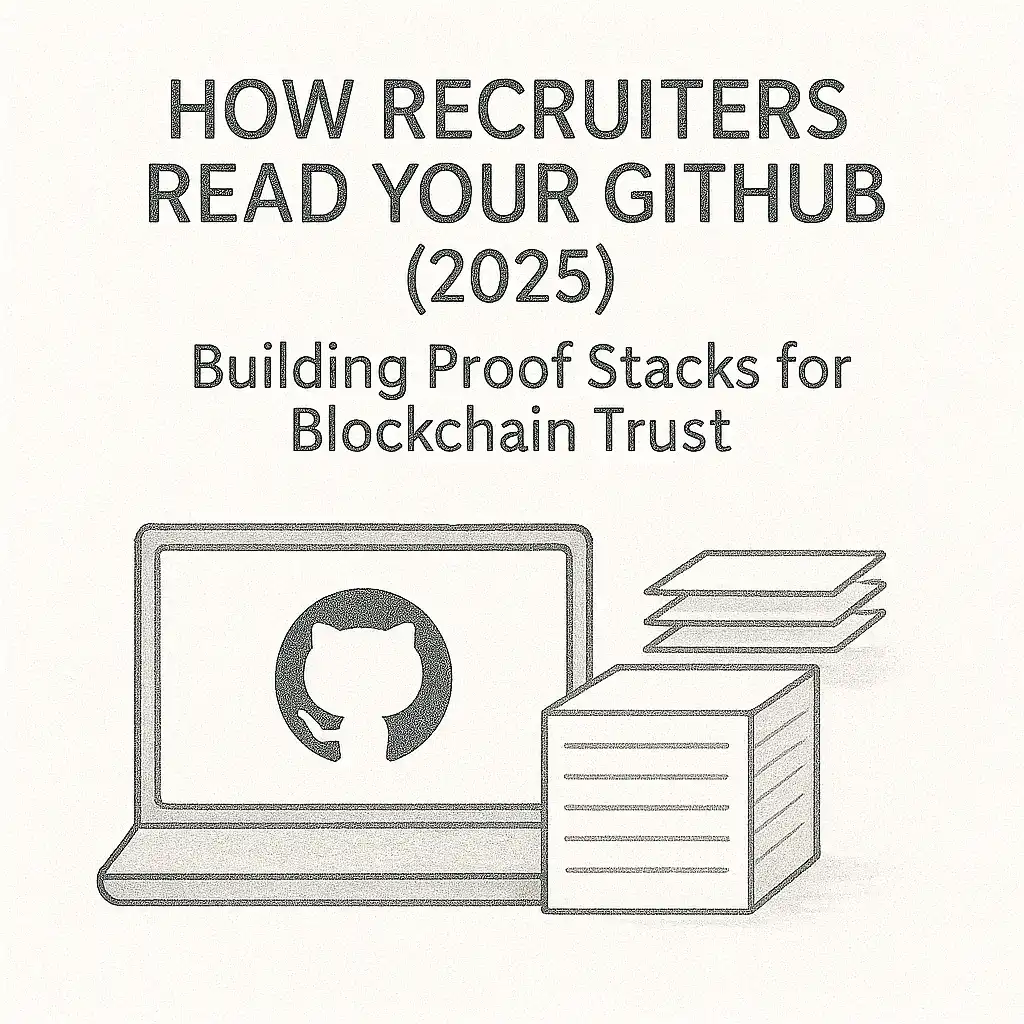
🧩 From Code Dumps to Proof Stacks GitHub used to be where developers parked their projects.
In 2025, hiring managers don’t browse portfolios — they audit them.
They trace how you built something, why you changed it, and whether your trail looks authentic.
A “flawless” GitHub with three neat repositories may impress a beginner, but to experienced reviewers it’s a red flag. Real builders leave fingerprints — commits, bug fixes, refactors, and small mistakes that show genuine learning.
That visible progress is what ArtofBlockchain calls your Proof Stack — a verifiable record of growth, decision-making, and collaboration that speaks before your résumé does.
If you haven’t read the background, start with ➜ Proof-Heavy Smart Contract Portfolios: What Hiring Managers Actually Trust (2025 Edition).
⚡ TL;DR for Scanners (Quick Summary)
GitHub = your public proof ledger, not just a code host.
Recruiters audit iteration trails, not polished snapshots.
Honest commit messages + readable docs = instant trust.
Non-developers can show Proof Stacks too — QA logs, design files, notes.
Use Insights, Actions, and Projects tabs to demonstrate consistency.
Link GitHub → AOB portfolio for full-circle credibility.
Proof > Perfection → Trust > Titles.
🔍 What Recruiters Actually Look for in 2025
Recruiters now read GitHub the way security auditors read Etherscan — they follow the proof trail.
Here’s what they check and how you can show it.
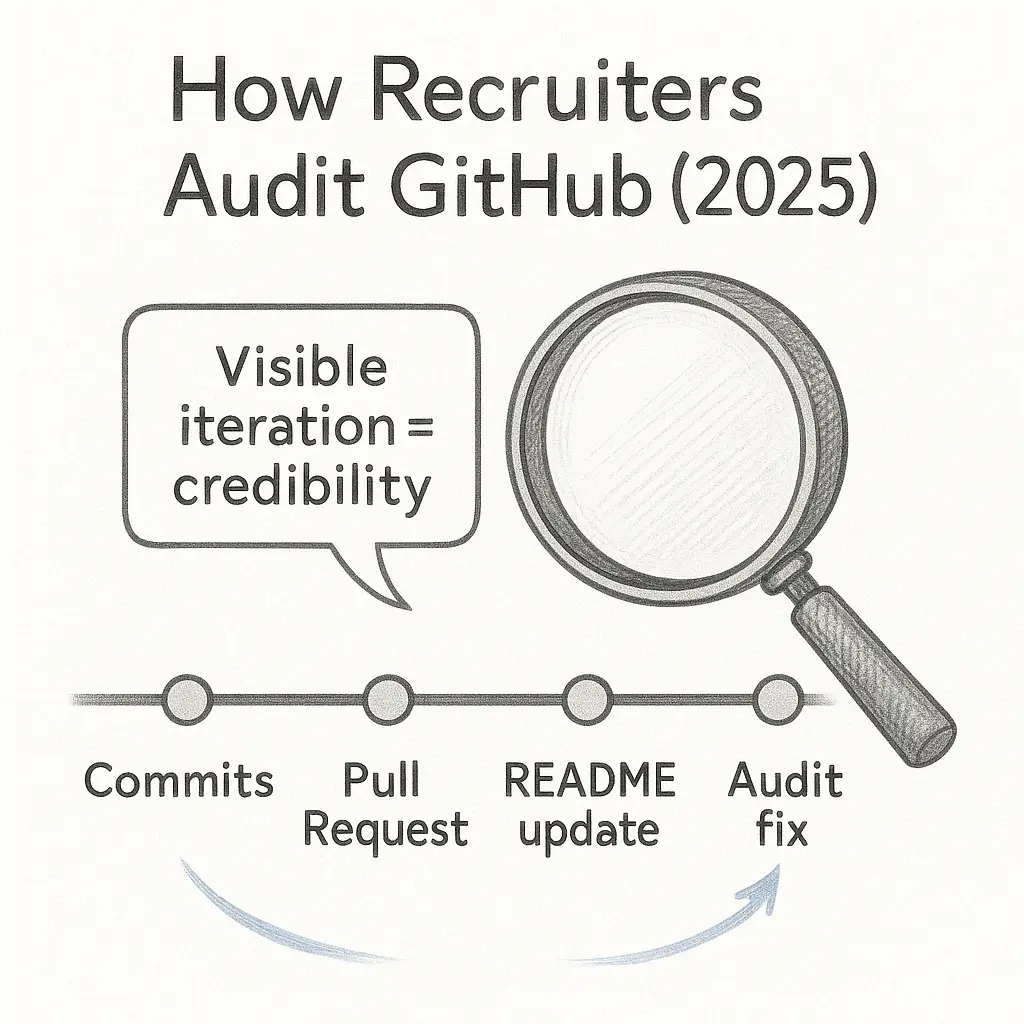
🧩 1️⃣ Commit Patterns — How You Record Progress
Every commit is a tiny timestamped note of what changed and why.
Hiring teams open this history to see steady, meaningful updates, not one-time uploads.
Examples of good commit notes:
“Fixed front-running bug in swap function.”
“Reduced gas cost by cleaning up unused storage.”
“Added test to check reentrancy fix.”
Frequent, short, clear commits show consistency and honesty — two traits blockchain companies prize.
🤝 2️⃣ Pull Requests (PRs) — How You Collaborate and Communicate
A pull request is your way of saying, “Here’s what I improved — please review it.”
Recruiters read PRs to understand how you explain ideas, accept feedback, and respond to reviews.
Keep them short and clear:
“Added SafeMath library to prevent overflow; improves contract security.”
When someone comments, reply with a fix or reasoning:
“Updated variable name and added one more test; thanks for catching that.”
Even small PRs on open-source projects show teamwork — proof that you can work with remote or global teams.
📄 3️⃣ Documentation Quality — Can a Non-Developer Understand Your Work?
Your README is the first thing most reviewers read.
Think of it as your project’s story:
What problem did you solve?
How does it work in simple terms?
How can someone run or test it?
What did you learn or improve?
A clear, friendly README tells non-technical managers you understand both technology and communication.
Add screenshots, test results, or a small “known issues” section — that honesty builds credibility.
 🧠 Turning Your GitHub Into a Proof Stack (Step-by-Step Guide)
🧠 Turning Your GitHub Into a Proof Stack (Step-by-Step Guide)
Think of GitHub as your career journal, not a storage drive.
Each update is part of your professional story.
Step 1 — Organize the Surface Layer (For Recruiters)
Write a short profile README explaining who you are and what you build.
Pin 3–5 repositories that show your best or latest work.
In each repo, add a one-line summary of why it matters.
Learn the structure here ➜ Building a Blockchain/Web3 Portfolio Site — Sections, Case Studies, and Metrics.
Step 2 — Keep the Middle Layer Transparent (For Developers)
Write clear commit messages: “Fixed token approval bug after audit feedback.”
Archive old branches instead of deleting them and explain what you learned.
Maintain a small CHANGELOG.md — “May: Fixed security bug · June: Added tests.”
Step 3 — Add the Deep Layer (For Security & Proof)
Include test outputs or CI logs.
Add a SECURITY.md file with a few known limitations.
Link to audits or testnet deployments when available.
Step 4 — Connect GitHub to Your Portfolio
Summarize your proof trail for non-technical readers through your AOB profile or personal site.
Example:
“Refactored staking contract → reduced gas by 20 % → merged after peer review.”
More examples ➡ Proof-Heavy Smart Contract Portfolios: What Hiring Managers Actually Trust (2025 Edition).
🪞 Visible Iteration vs. Flawless Curation (Why Imperfection Builds Trust)
Many candidates ask, “Should I clean my GitHub before applying?”
Clean for clarity yes — but don’t erase your learning history.
Recruiters trust a repo with honest iteration more than a spotless profile.
Why Visible Iteration Wins
Shows you’ve solved real problems.
Builds trust through transparency.
Proves you learn quickly and document that growth.
A curated GitHub can look fake; a working GitHub looks authentic.
Add simple notes like “Improved audit coverage after feedback” or “Moved from Hardhat to Foundry for better testing.”
Those lines tell your story better than any tagline.
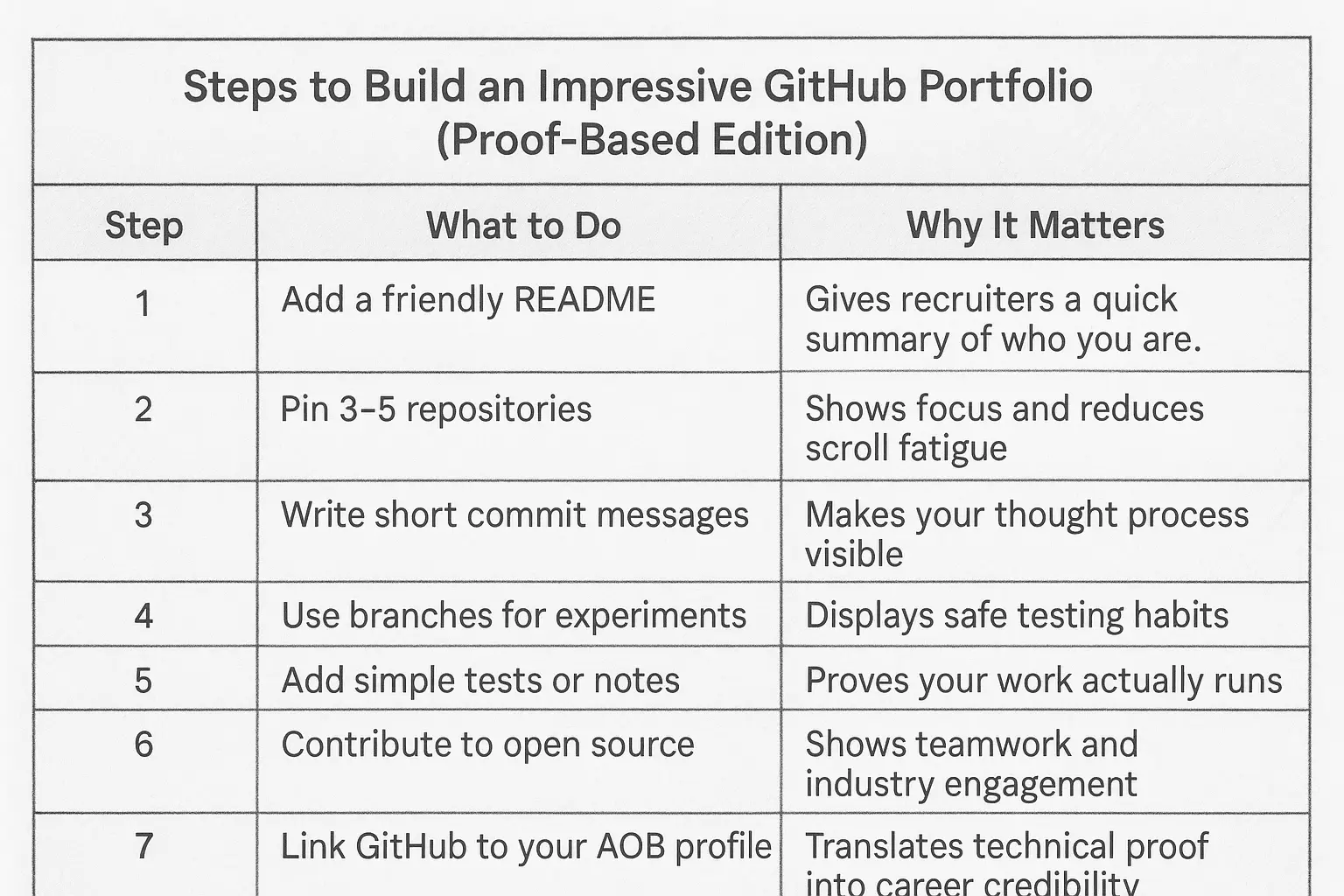
Key Takeaway: Recruiters aren’t searching for perfect engineers — they’re searching for people who keep improving. Visible iteration is proof of that growth.
From Non-Developer Proof to Recruiter Trust
💼 4️⃣ Visible Iteration for Non-Developers
GitHub isn’t only for coders. Anyone working in blockchain can use it to show their process instead of hiding it.

🧪 QA & Security Testers
Keep versioned test results: v1 failed → v2 patched → v3 passed on testnet.
Add short audit notes such as “mock RPC added → flaky tests dropped from 12 % to 1 %.”
Link each bug report to the pull request that fixed it for clear traceability.
See real examples ➜ AOB QA Proof Thread.
🎨 Designers & UI Engineers
Export Figma history with comments: “simplified staking flow after user tests.”
Commit design tokens or CSS updates with a note on usability impact.
Before/after screenshots instantly show improvement.
🖋️ Writers & Content Strategists
Save each draft and revision as a commit.
Add reasoning: “clarified zk-SNARK analogy after reader feedback.”
Create branches for newsletter edits, whitepaper rewrites, or SEO changes.
📊 PMs & Ops Roles
Upload sprint summaries and decision logs.
Tag metrics (“gas cost cut 40 % after zk-rollup migration”).
Use the Projects board to visualize tasks closed per sprint.
Pattern: Trace your thinking → show your decisions → earn trust.
⚠️ 5️⃣ Common Mistakes That Kill Credibility (and Easy Fixes)
Even smart professionals accidentally erase the very proof recruiters look for.
1. Deleting Commit History
When you delete past commits, you remove the evidence of progress. Archive instead of erasing.
2. Going Fully Private
A private profile hides your learning curve. Keep at least one public demo or open-source contribution.
3. Copying Without Credit
Forking is good; plagiarism is not. Always credit the original source in your README.
4. Uploading Only Final Versions
Recruiters value process. Show early drafts, failures, and fixes with short notes.
5. Skipping Docs & Tests
Even small test files or instructions prove your code or workflow runs as claimed.
🧭 If someone can’t trace how you improved something, they can’t trust you built it.
🪜 6️⃣ From Iteration to Credibility — The Recruiter’s Trust Ladder
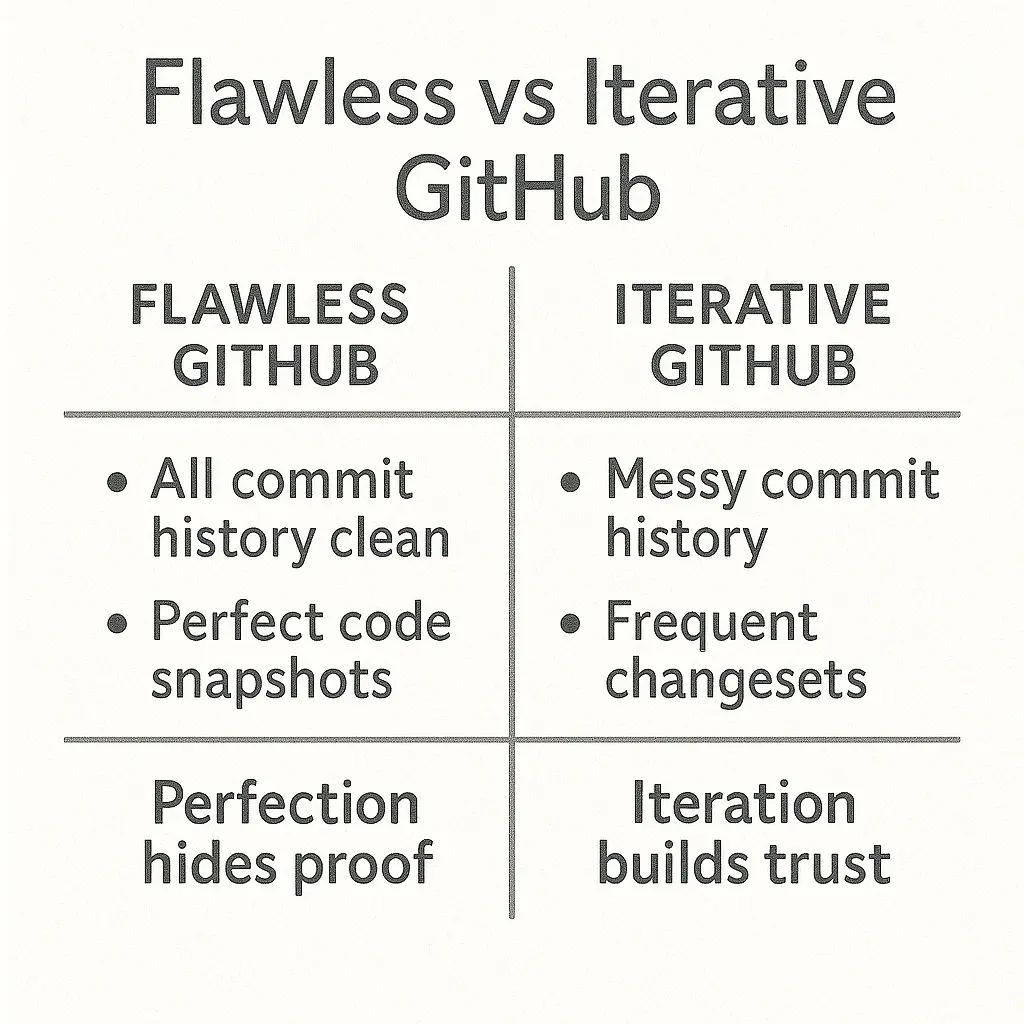
A candidate who shows all three is far easier to shortlist — their trail reads like a transparent audit.
For converting these signals into public portfolios, check ➜ Building a Blockchain/Web3 Portfolio Site — Sections, Case Studies, and Metrics and Proof-Based Hiring Signals for Smart Contract Auditors.
💬 Founder’s Note
“At ArtofBlockchain.club we’ve seen hundreds of portfolios that looked perfect but told no story. In blockchain careers, proof beats polish every time. A visible GitHub trail — commits, reviews, audit notes — is the new trust currency of 2025.”
Join the live discussion ➜ How Recruiters Evaluate GitHub Portfolios in 2025.
💡 GitHub for Non-Techies (Made Simple)
If you’ve never used GitHub, imagine LinkedIn + Google Docs with automatic timestamps.
Every change you make — a note, design update, or bug report — is recorded forever.
You can use it to showcase improvements just like developers showcase code.
Upload reports, screenshots, or documentation; write a one-line commit like “updated user flow after testing feedback.”
Over time, this becomes your visible Proof Stack.
Learn the basics here → GitHub’s Version Control Guide.
🧭 Steps to Build an Impressive GitHub Portfolio (Proof-Based Edition)
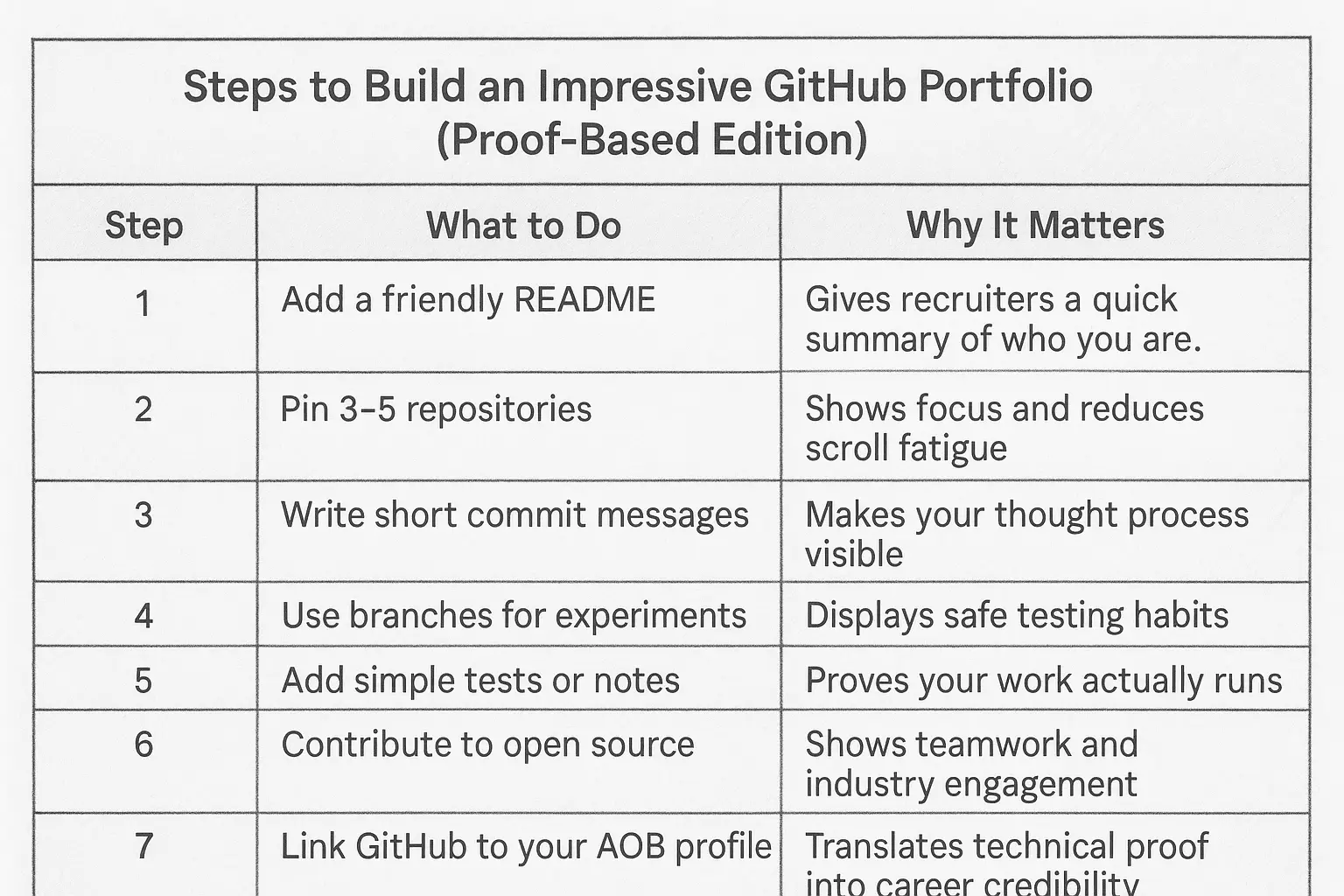
🧱 Recommended GitHub Features to Highlight (2025 Hiring Perspective)

Authoritative resources for further learning:
ConsenSys Academy — structured blockchain learning.
Trail of Bits Blog — security case studies.
GitHub Docs — official basics of version control.
📘 Conclusion — Proof Over Perfection
GitHub is no longer just a code locker; it’s the public ledger of how you work.
Every commit, note, or pull request acts like a digital footprint of your learning curve.
Recruiters don’t search for perfect profiles — they search for proof of progress.
If you can show consistent updates, honest documentation, and lessons learned, you instantly appear more trustworthy.
Whether you’re a developer, designer, QA analyst, or content strategist, your visible trail tells the story of improvement — and in blockchain careers, trust = opportunity.
Keep building, documenting, and linking your Proof Stack to your AOB portfolio so your work speaks before you do.
❓ FAQs
Q1. Is GitHub only for developers?
Not at all. GitHub simply keeps versions of your work — whether it’s code, design, QA reports, or product notes. Anyone in blockchain can use it to show how their ideas evolve and improve.
Q2. Why do recruiters check GitHub profiles now?
Because GitHub reveals real behavior — how you fix bugs, document thoughts, and respond to feedback. It’s faster and more honest than a résumé full of buzzwords. Recruiters want proof, and GitHub gives them that audit trail.
Q3. What makes a GitHub portfolio impressive to hiring teams?
Clarity, consistency, and context. Small, regular commits with clear explanations show reliability. Add simple READMEs and test notes so anyone — even a non-developer — can understand what changed and why.
Q4. How can beginners build a Proof Stack without coding?
Start by versioning everyday work: bug reports, UI sketches, process notes. Each update you commit becomes proof of your growth. Over time, those small iterations show you’re serious, organized, and improving.
Q5. Do I need followers or stars to look credible?
No. Engagement helps visibility but isn’t a trust signal. Recruiters focus on authentic, traceable work — your commits, comments, and documentation matter far more than vanity metrics.